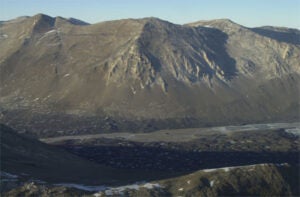Credit: Robert Simmon, based on data provided by the NASA GSFC Oceans and Ice Branch and the Landsat 7 Science Team.
Image acquired by Landsat 7 Enhanced Thematic Mapper plus (ETM+) instrument, December 18, 1999.
Project Abstract
The glacial streams of the McMurdo Dry Valleys have extensive cyanobacterial mats that are a probable source of fixed C and N to the Valleys. The research will examine the interplay between the microbial mats in the ephemeral glacial streams and the microbiota of the hyporheic soils (wetted soil zone) underlying and adjacent to those mats.
It is hypothesized that the mats are important sources of organic carbon and fixed nitrogen for the soil communities of the hyporheic zone, and release dissolved organic carbon (DOC) and nitrogen (DON) that serves the entire Dry Valley ecosystem. Field efforts will entail both observational and experimental components. Direct comparisons will be made between the mats and microbial populations underlying naturally rehydrated and desiccated mat areas, and between mat areas in the melt streams of the Adams and Miers Glaciers in Miers Valley. Both physiological and phylogenetic indices of the soil microbiota will be examined.
Observations will include estimates of rates of mat carbon and nitrogen fixation, soil respiration and leucine and thymidine uptake (as measures of protein & DNA synthesis, respectively) by soil bacteria, bacterial densities and their molecular ecology.
Experimental manipulations will include experimental re-wetting of soils and observations of the time course of response of the microbial community. The research will integrate modern molecular genetic approaches (ARISA-DNA fingerprinting and ultra deep 16S rDNA microbial phylogenetic analysis) with geochemistry to study the diversity, ecology, and function of microbial communities that thrive in these extreme environments.
Credit: Kristan Hutchison, National Science Foundation. Antarctic Photo Library, U.S. Antarctic Program.
Kristan Hutchison, National Science Foundation
Publications:
- Cowan et al. (2011). Hypolithic communities: a hidden nitrogen source in Antarctic desert soils.
- Environmental Microbiology Reports Vol. 3, Issue 5, pp. 581–586. (pdf).
- Neiderberger et al. (2015) Microbial community composition of transiently wetted Antarctic Dry Valley soils.
- Niederberger et al. (2016) Carbon-fixation rates and associated microbial communities residing in arid and ephemerally wet Antarctic Dry Valley soils.
- Niederberger et al. (in press) Rapid microbial dynamics in response to an induced wetting event in Antarctic Dry Valley soils.
- Sohm et al. (in press) Microbial mats of the Dry Valleys: oases of
biological activity in a very cold desert.
See Also:
Poster: Diazotrophic activity and diversity in the Dry Valleys, Antarctica. Jill Sohm et al. (2011) (pdf)
NSF Office of Polar Programs: McMurdo Station
McMurdo Dry Valleys Long Term Ecological Research (LTER)

